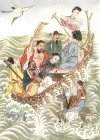Below is an abbreviated introduction to the eight immortals of Chinese Tradition, and one of their legends. These immortals are believed to have achieved immortality through different means and left this earth to live in an entirely different realm, but at the same time interacting with us.
Of course you will understand this falls into the realm of mythology, but I have known people who are willing to believe many things even stranger than this.
The Eight Immortals are a group of legendary xian, also known as immortals, transcendents or fairies, from Chinese Tradition. Each of the individual immortal's power can be transferred to a tool of power that can give life or destroy evil. Together, these eight tools are called "Covert Eight Immortals". Most of them are said to have been born in the Tang Dynasty or Song Dynasty. The 8 immortals are revered by the Taoists, and are also a popular element in the secular Chinese culture. They are said to live on Penglai Mountain-Island.
Pa Hsien
Either singly or in groups the Eight Immortals, Pa Hsien, of the Taoist religion are one of the most popular subjects of representation in China; The term ‘Eight Immortals’ is figuratively used for happiness. The number eight has become lucky in association with this tradition, and persons or things eight in number are graced accordingly. In them we see “the embodiment of the ideas of perfect but imaginary happiness which possess the minds of the Chinese people.”
Three of them (Chung-li Ch’üan, Chang Kuo, and Lü Yen) were historical personages; the others are mentioned only in fables or romances. They represent all kinds of people—old, young, male, female, civil, military, rich, poor, afflicted, cultured, noble. They are also representative of early, middle, and later historical periods.
The legend of the Eight Immortals is certainly not older than the time of the Sung dynasty (A.D. 960–1280), and is probably to be assigned to that of the Yüan dynasty (1280–1368). But some, if not all, of the group seem to have been previously celebrated as Immortals in the Taoist legends. Their biographies are usually arranged in the order of their official eminence or seniority in age. These are the eight:
Li T’ieh-kuai
Chung-li Ch’üan
Lan Ts’ai-ho
Chang Kuo
Ho Hsien Ku
Lü Tung-pin
Han Hsiang Tzŭ
Ts’ao Kuo-chiu
Pa Hsien Kuo Hai
The phrase Pa Hsien kuo hai, ‘the Eight Immortals crossing the sea,’ refers to the legend of an expedition made by these deities. Their object was to behold the wondrous things of the sea not to be found in the celestial sphere.

The usual mode of celestial locomotion—by taking a seat on a cloud—was discarded at the suggestion of Lü Yen who recommended that they should show the infinite variety of their talents by placing things on the surface of the sea and stepping on them. Li T’ieh-kuai threw down his crutch, and scudded rapidly over the waves. Chung-li Ch’üan used his feather-fan, Chang Kuo his paper mule, Lü Tung-pin his sword, Han Hsiang Tzŭ his flower-basket, Ho Hsien Ku her lotus-flower, Lan Ts’ai-ho his musical instrument, and Ts’ao Kuo-chiu his tablet of admission to Court.
The popular pictures often represent most of these articles changed into various kinds of sea-monsters. The musical instrument was noticed by the son of the Dragon-king of the Eastern Sea. This avaricious prince conceived the idea of stealing the instrument and imprisoning its owner. The Immortals thereupon declared war, the details of which are described at length by the Chinese writers, the outcome being that the Dragon-king was utterly defeated. After this the Eight Immortals continued their submarine exploits for an indefinite time, encountering numberless adventures; but here we fall into the fertile region of romance, beyond the frontiers of our present province.
Ok, remember this is folklore, not true, but could there be something real behind this?
Of course their are thousands of legends of these immortals, I have read a few, but the thing is we also have people deemed as immortal in our Western culture, for example the Count of St Germaine, I find these type of accounts very interesting.
